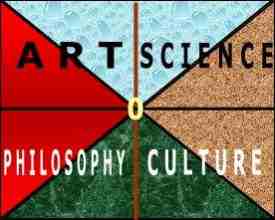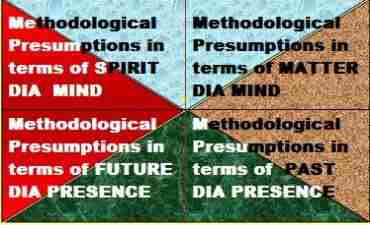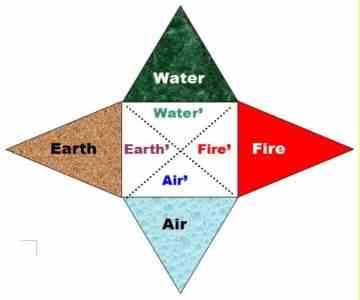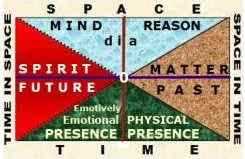Peculiarities of the Dialectical Interactive Approach

The Background Simulative Methodological Assumptions of the Dialectic Interactive Approach
DIA

The Ultimate DIA Probable Methodological Presumptions of the Dialectic Interactive Approach
It is now much easier to understand, why this creator of knowledge prefers the recorded ANCIENT citations of the actors of this distant past, who lived and creatively acted on these earthly expanses. Although some of you, seen from the perspective of the MODERN understanding and comprehending ROLE of art, science, philosophy and culture, might argue that the great thoughts of these actors of the remote past is feasible to substitute and utter at this new level of time DIA space of this modernized understanding of this concept, their TIME VALUE (THOUSANDS OF YEARS) is not possible to substitute and replace in any way, particularly, after incorporating the related spatial value [spirit, mind dia reason, matter]. And as it was demonstrated by this creator of knowledge in the creative works and articles of his, their great thoughts are still VERY actual, valid and will continue to be that in the future as well. In short, the "modern creative" and narrow-specialised comprehension of the role of science OR philosophy OR art OR culture during the process of creating knowledge, demands (exclusively) citation of the latest creative achievements within a narrow-specialised realm of science, where also implementation of the interdisciplinary approach is rather a rarity. Note too, how they are particularly ('creatively') oversensitive and easily upset on the embodiment of citations of the major actors of HOLY BOOKS AND SCRIPTURES in the creative works by the ("scientific, philosophic, artistic and cultural") intruders. This creator of knowledge is only one example of this kind of intruders. Regardless of this, the dialectical interactive approach because of its "Background Simulative Methodological Assumptions" requires that each dialectical content under creative consideration is reconsidered from (tri)angles of the great pyramid of culture, philosophy, art and science, understood in terms of suitable "Ultimate DIA Probable Methodological Presumptions of the Dialectical Interactive Approach".
Since religion in full agreement with hidden ancient knowledge is the core of any established culture, permeating its every aspect and mode of expression, the great ideas and thoughts of their creators should also be incorporated and applied to creative purposes, wherever expedient. As an example of the influence and permeation of culture by religion, regardless of the form in which religion is manifested within the established social community (animism, paganism, God's creeds, atheism, modernized pagan distortion and interpretation of these God's religions, various ethical conceptions and surrogates for religion), that this not only influences the course of cultural and social events but also plays a decisive role within the established culture and society, determining and influencing both the course and the way of development and application of art, philosophy, and science. In other words, as some form of manifestation of ethical values and religious beliefs is woven at the core of every established culture, a culture which is developed on this basis in interaction with art permeated the development of every social community from the very beginning of its establishment. As proof of the above, compare this contemporary manifestation and role of culture and art both in terms of space (within various established social communities on planet Earth) and in terms of time, that is, in various epochs of development of these social communities.
- Giotto Di Bondone (1266-1337), the first great artist of the Italian Renaissance, saw nature in a new perspective and light, and for the first time painted people, rocks, and trees in three-dimensional space and form. He introduced the technique of precise drawing from life which emphasized the elegance of posture and eloquence of gestures of his figures and paintings with lots of realistic details.
- Although he did not change the geocentric model of the universe or present a new understanding of time and space, his artistic activity initiated long-term processes that led Europe out of the Black Middle Ages. In addition, he showed with his artistic approach and creative action how art not only influences and changes culture but also its core: religion.
Why then is some way of expressing religion indispensable and irreplaceable within the established social community? First of all, every established social community consists of several individuals, and each of its members has its own inner space that must be filled with something, and therefore it is always filled with appropriate religious, ethical and social values, which in fact keeps that formed social community as a whole. Otherwise, the formed social community falls apart. In other words, efforts to empty and vacuum these inner spaces are futile, because it can only be filled or replaced with something else. Since people and human beings have always been surrounded by unknown and inexplicable phenomena, which frightened them and often brought them to their knees, religion and the established religious institutions were a refuge where one could find comfort and explanation of these unknown phenomena, as well as a temporary shelter and escape in the formed religious community from the unknown and inexplicable.
In short, these unknown and inexplicable phenomena were perceived as a kind of warning and punishment by some invisible deities for their inappropriate behavior and various crimes committed, which led to the development of the concept of distinguishing good from evil within these formed social communities, where religion played the role of glue that held its members together. This type of awe at meeting the unknown and inexplicable was present in every epoch of development of the established social community. In fact, this is still the case today, although the rapid development of science has encouraged and blinded these modern know-it-alls. In short, although religion as the core of every culture in interaction with art actually initiated the development of knowledge in order to find answers to these unknown and inexplicable natural phenomena, that is, the development of philosophical thought and science in the deeper and broader sense of these terms, it simultaneously led to a weakening of the role of this original religion and its gradual replacement by philosophical and scientific new-interpretations of these unknown phenomena, as well as to the emergence of appropriate surrogates based on it.
Although in my opinion, any religious and ethical conception of distinguishing good (right and just) from evil (wrong and unjust) is very difficult to take root in any natiocratic environment where evil (wrong and injustice) prevails that allows the making of right or just decisions, judgments, or reasonable conclusions, which will satisfy everyone and all during the (creative) consideration of some dialectical content, this concept cannot be excluded from life and creative reality. For this reason, the concept of distinguishing good from evil plays a major role during any kind of interactively creative debate using the dialectical interactive approach, as this is the only bipolar dilemma (stumbling block), that remains to be solved using this methodological approach. In other words, every manifestation of the bipolar dilemma should be resolved in the sense of choosing the currently best creatively feasible option within the available and creatively accessible choices and paths in this particular scenario in the time DIA the corresponding situation in space, understood in the sense of mutually complementing and supplementing the considered dialectical content in terms of thesis and antithesis (paired dialect). For example, the words of Christ ("The Kingdom of God is within thee") can be understood and creatively applied in terms of both earthly and heavenly ("New Jerusalem") understanding of the concept-future. In full agreement with this attitude, this creator of knowledge also applied these great words to develop the earthly conception and understanding of the term-future instead of their usual black-and-white way (either-or) of implementing the natiocratic division of powers, responsibilities and work duties in the sense of: either culture dia religion in its "heart" or art or philosophy or science.
In short, the chosen method of creative application of these words of Christ by this creator of knowledge in collaboration with other great humans of the past (Plato, first of all, who was neither a prophet nor God's messenger), as well as with the latest knowledge related to this dialectical content under creative consideration, in fact enabled this creator of knowledge to rank among the greatest thinkers who have already developed existing post-Copernican models, concepts, and understandings of time and space (Newton and Einstein). But this creator of knowledge, apart from this dialectical understanding of time and space, also developed a humane, creatively individual way of thinking (Dialectical Creatively Interactive Approach), which is currently the most advanced methodological approach. In the broad framework of this methodological approach, there is a place for everyone, regardless of the era in which they were creatively active, including their religious affiliation, which allowed Plato to enter this great door that this creator of knowledge opened for him to also perform on this magnificent stage, which is completely different from this modern natiocratic way of dealing with dissenters or those whose color is not black or white.
In my opinion, every human and human-loving being has been trying to make his contribution to humanity, or at least to leave a mark that leads humanity to eternity, finding ways to do it in various ways, that is, according to their real possibilities. As another example, let me mention the way in which Nicolaus Copernicus, a mathematician, cosmologist, and clerical scholar, reversed the course of development of this civilization, or Giordano Bruno (Dominican friar, philosopher, poet, cosmologist, and esotericist) who tried to further pave this newly opened (cosmological) path, and because of that, he was burned alive at the stake. For all the aforementioned reasons in full compliance with the Dialectical Interactive Approach, the great ideas and thoughts of these great humans of the past must not be excluded from application for creative purposes using their black-and-white methodological approach, that is, the ruling bipolar dia binary way of thinking, as well as this way of solving problems within the established social community.
In short, the creation (of knowledge) through expressed creativity does not recognize and does not know any boundaries or limitations, and especially they do not recognize these bipolar, black-and-white boundaries and limitations of creative activity. In fact, the creation (of knowledge) through manifested creativity is essentially the search for answers to the unknown beyond the boundaries of the known in a creative collaboration with the already (insufficiently) known, most often by contradicting them in the sense of matching and paired thesis and antithesis. For this reason, these cross-border crossings into the zones of the unknown, especially in the area of prohibited creative activity, are an inevitability, especially seen from an individual point of view. On the other hand, the natiocratic representatives of the simple-minded and vulgar way of acting and thinking within the boundaries of the known have always tried to prevent this, because every new knowledge imposes a re-definition of the established way of ruling over the masses and groups of people.
Regardless of all this, there have always been and will be (great) individuals who were ready to step deep into these vast expanses of the unknown, as well as to find their way back precisely through moving the boundaries, that is, expanding the horizons of the known. Since all proponents of this individual journey into the unknown, regardless of which ethical, religious, or racial group they belong to, are connected with more or less similar life trajectories and corresponding adversities, they are intrigued by the creative achievements, life stories, and the committed earthly sins of their predecessors and the like-thinkers, which various earthly parasitic gods and "princes of the Earth from ancient times" could not forgive them. In other words, despite their acquired power (and wealth), they were not given this desirable gift of God. Or to put it another way, the answer to the unknown will first be sought in the creative works of like-minded individuals and sufferers, if nothing else to find creative inspiration and the idea of how to creatively move forward within these vast creative expanses of the unknown. Such a discarded concept into their abyss of oblivion and darkness, and which is contained in old books from antiquity, precisely as the end result of further modernization and vulgarization of simple mind dia reason, is the concept of ether.

The Unity and Exerting of Dialectical Tensions in Time DIA Space
DIA
The Four Primary DIA Proto Paradigmatic Presumptions of the Dialectic Interactive Approach
and so on in Time DIA Space, until was reached stage of the development of

CREATIVE EXPANSES OF A FOUR-TRIANGULAR STAR

This ground plan was eternalized in the Pyramid of Cheops in Egypt
Note that the dialectical interplay of these four SYMBOLICAL pre-ancient dialects take place within a PICTURESQUE geometrical rectangle (square), in which are placed The Four Primary DIA Proto Paradigmatic Presumptions of the Dialectic Interactive Approach, whose image was imprinted DIA impressed in the ground plan of Cheops' (Khufu’s) pyramid, as a kind of embodiment of THESE CREATIVE VASTES OF THE FOUR-TRIANGULAR STAR. In other words, it might be argued that in this way, this pre-ancient methodological approach to creating knowledge had been perpetuated (and hidden), respectively, allowing it to come again on the light of day, in the case that this important part of the higher (hidden) knowledge was lost, from one or another reason. By the way, on the basis of rumors and speculations about the role of the floor plan of this pyramid (its "fifth" side), those who were not familiar with this hidden knowledge, Aristotle (as well as in the written sources of the Far Eastern culture) called it the FIFTH ELEMENT ( ether ). But taking into account the fact that on the ground plan of this pyramid, the dialectical processes of the standard manifestation of the ether concept take place, as well as the further interactive action, refinement, and enrichment of the four basic elements (fire, water, air, earth) on a new, preferably at a higher level of time DIA space (the layer of this pyramid of time and space), they cannot be qualitatively equated with this "fifth" element (ground plan: the ground sketch of the pyramid).
In other words, the ether represents a general (standard) creative working framework (for example, a vacuum), but also every specific created environment and creative ambience [wrapped on all sides with an invisible protective membrane] on one of the levels (building blocks) of this pyramid of time and the space within which these four elements interact creatively and cooperate with each other. Examples of the manifestation of the created ether-environment are the interplanetary star space (stellar system), interstellar spaces, galactic spaces, inter-galactic spaces, etc., while examples of the created ambient or micro-ambient are: the earth's atmosphere, the activity zone of black holes, supernovae... . From the above, it follows that the vacuum, as an almost empty airless space, actually represents an ideal neutral environment and ambience for the standard manifestation of the ether, and for this reason it occupied space (and time) on the ground plan of this pyramid.
The Earth's atmosphere is one example of the manifestation of the ether at the higher level of this pyramid, created as a result of the interactive creative action, permeation, and enrichment of these four basic elements. The Earth's atmosphere not only provides the conditions for the emergence of life but also protects life on Earth by creating protective layers and envelopes, as well as the appropriate atmospheric pressure of this created ambient in mutual cooperation with the force of the Earth's gravity, which in fact enables the creation of liquid water, as well as its retention on the surface of the Earth. By the way, every resulting ambient contains some manifestation of a protective covering, which actually separates it from other ether-ambients. Due to this special (protective) role of this form of manifestation of ether-vacuum and its ability to metamorphose into various forms of manifestation of ether-ambient, which actually created the necessary environment and desirable ambient for the emergence of life, as well as the conditions for its maintenance, it could be said that this is really about a (HIGHER) SUPER-ELEMENT, and not about some fifth, non-existing element. For additional information related to the ancient understanding of the concept - ether, read the creative article: Conception of Ether in Ancient Hidden Knowledge.
In any case, this linguistic "pictographic script" (of symbols) evokes and calls to mind dia reason, by awakening and setting in motion dormant thoughts, which were impressed, imprinted, and stored DIA hidden deep in the subconscious and unconscious ("imaginative server") of human beings and humans, and which can be retrospectively recollected and revived in time DIA space, with a "little" help of the dialect - spirit of those beings with (deep) human roots. Self-realization and the knowledge of having this kind of ability motivates humans and human beings further to stubbornly continue to carry their heavy "chests of drawers" (inner being), filled with (hidden and invisible) dialectical contents of human culture, philosophy, art of science. Along the way, still carrying the burden of this treasure of humanity, they try to convince others, regardless of the price that has to be paid for it, that there really is something valuable for the future (generations) in their heavy "chests (bookcases)". The creative articles, recorded by this creator of knowledge, working creatively within me, also prove that they were right. For this reason, let's look together into this kind of burden (of meaning) to be human and human-loving (being).
For this purpose, in order to fulfill this creative requirement, related to the role of dialects - cultures were also cited DIA CREATIVELY APPLIED words of the main actors of the Holy Books and Scriptures, which was not at all warmly received by "modern ideologues and 'theologians'", who operate (behind the hidden sceneries of accumulated inner darkness) within the established official natiocratic institutions of the "modern" science, philosophy, art and culture dia religion embedded in its core. In fact, they would like this part of humanity's treasure never to be used during the KNOWLEDGE CREATION PROCESS, and to remain forever inside these well-insulated (and fully monitored) "container walls of theirs", as if it were some nuclear (radioactive) waste. In other words, these "containers" of theirs were exclusively used for the purpose of some kind of modern edition of "catacombs" for practicing God's confessions, by enjoying this kind of religious freedom, BUT NOT ALSO THE FREEDOM OF CREATIVE ACTION, that is, the use of ideas and thoughts of these great humans of the distant past FOR CREATIVE PURPOSES. All this is in complete accordance with the typical way of applying the natiocratic "social division of powers, responsibilities, and work duties" for the purpose of preserving these black-and-white value systems of the established natiocratic order. A good example of this methodological approach to the creative implementation of the (dialectical interplay of) culture DIA religion, science, philosophy and art is the following creative article: The Concept of the Dialectical Time DIA Space VERSUS The Concept of (Recti)linear Space AND Time.
At the same time, reading the remaining ancient and antique sources, and especially the Holy Books and Scriptures, understood in the sense of a dialectical synthesis (summarization) of this huge span of time DIA space (THOUSANDS OF YEARS), provides an opportunity to finally understand that from these ancient and antique times DIA suitable spaces to the present day have not changed so much ESSENTIALLY in the treatment of (ordinary) people in relation to the privileged treatment of various group societal categories by the state and established network structures. On the other hand, there are very powerful natiocratic forces ('modernists'), who would like to prevent THIS KIND OF LONG-RUN dialectical synthesising IN TIME [future, emotively emotional dia physical presence, PAST] DIA SPACE [SPIRIT, mind dia reason, matter] at any price. In other words, they would like to prevent the development of the ability and capability of this way of LONG-TERM dialectical synthesizing of such a huge span of time DIA suitable range of space, which includes and cross-bridges both past and future DIA thy creative (emotively emotional) dia physical PRESENCE, and not only in the sense of their conception and understanding of the term "future", seen and sought within the creatively very limited access of most citizens (individuals) to this "container" of time known as the present.

(Recti)linear Creative Framework for the Orientation in Time AND Space
On the other hand, concluding this initiated dialectical process, this creator of knowledge is truly amused by how many manifested paradoxes, self-deceptions, and (optical) illusions of (recti) linear perception and understanding of time and space can be stored within the limits of this "container" - present, in mutual interplay with the abandoned hollow, related to the already proverbial neglecting the role of the dialect - past by the fused (merged) minds of these "modernists", during their (CREATIVE) orientation in time and space. And all this, although the well-known creative achievements of cosmology also contradict to this very wide spread 'scientific' (methodological) approach. "As farther a look to the observable universe was thrown, as better the (face of events of the distant) past has been seen". Or by uttering this cosmological view on the universe in terms of the used terminology of dialectical interactive approach, my ⇄ thy ⇄ our PHYSICAL PRESENCE is surrounded from all sides by the dialect - (matter in the) past (SPACE IN TIME). But these (external) experiences and limitations of time and space ARE NOT ALSO VALID FOR THE DIALECT - EMOTIVELY EMOTIONAL PRESENCE.

Dialectical Creative Framework for Orientation in the Eternity of Times DIA Infinity of Spaces
In other words, only this kind of dialectically SPIRITUAL (creative) presence is able to peer into the INVISIBLE INNER EXPANSES, as well as into unknown external vastness of this way of dialectical conceiving and understanding of (the dialect -) FUTURE, that is, to look into the immense expanses of dialectical worlds of TIME IN SPACE: future wrapped IN SPIRIT, as well as into the vast tiny (infinitesimal, diminutive) expanses of the micro-universe (the world of dialectuls). After these few dialectical statements, all the (methodological) shortcomings and (creative) inconveniences of the scientific exclusion of dialect-spirit from 'modern' scientific thought came to light, generally speaking, only because it is objectively (and mathematically completely) immeasurable, and for this reason physically (from the point of view of the dialect - matter) insignificant and worthless. Regardless of this, for the purpose of retrospectively recollecting, recalling, and reviving these stored (dormant) patterns of thought, that is, their transmission and translation in the medium - mind dia reason, linguistic dialects of the "Background Simulative Methodological Assumptions of the Dialectical Interactive Approach" (culture, philosophy, art, science) were again used, understood in terms of placing them into the suitable dialectical creative context by means of the "Ultimate DIA Probable Methodological Presumptions".









